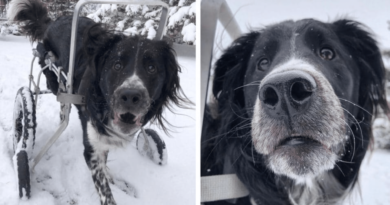25 Very Serious Dog Health Symptoms That You Should Never Ignore
Dogs are good at hiding illnesses from their owners. This behavior is inspired by dogs’ ancestors that used to hide when they were sick, because a sick dog was vulnerable out in the wild. Sometimes, your dog’s sickness simply isn’t severe enough to warrant a trip to the vet, but there are many serious dog health symptoms that you shouldn’t ignore.
1. Difficulty Urinating
If your dog is having difficulty urinating, this could mean that there is a blockage or, even more likely, the dog may have attracted urinary tract infection (UTI). Excessive urination or straining when trying to urinate could also be symptoms of a tumor, and something that needs to be addressed quickly.
2. Excessive Thirst
If you find yourself constantly replenishing your pet’s water bowl because the dog is drinking excessively, potentially along with gagging, diarrhea or tightness of the stomach, the cause of this could be canine bloat, which is also known as gastric torsion or gastric dilatation volvulus (GDV). Drinking too much is also a very common symptom of liver disease, diabetes and bladder stones. When you’re walking the dog, keep an eye on just how much urine he is passing.
3. Lethargy
There’s an extremely long list of reasons as to why your dog may be lethargic and constantly tired, including urinary tract infections, heartworm, bacterial and parasitic infections, viruses and more. These conditions will cause your dog to be sleepy, refuse to play, and he will be moving around a lot less than usual.
4. Scooting
When a dog is scooting on the floor, it’s because their behind is itching or otherwise bothering them. Most commonly, this is caused either by worms or anal gland problems. Worm infestation can be easily treated with a dewormer, while fluid that have built up in your dog’s anal sacs will be drained at your vet’s office.
5. Weight Loss
If you’ve noticed that your dog started losing weight all of a sudden, and quite quickly too, this could be a sign of many different conditions which must be addressed immediately: worm or parasitic infestation, nervous system disease, digestive disorder, liver or kidney disease, diabetes or cancer.
6. Gum Inflammation or Discoloration
A dog’s gums are a very good indication of their current health status. Inflammation of your dog’s gums could be a sign of gingivitis, and with gingivitis your dog is likely to have bad breath too. Gum inflammation can also be caused by many dental diseases and other oral inflammations. Discoloration of the dog’s gums, such as them being pale, is another something of several potential diseases.
7. Loss of Appetite
When a dog refuses to eat, it could simply be they really don’t like the food you’re offering. However, if this has been going on for a few days, then it’s a sure sign of a number of potential diseases. Most commonly, dogs lose appetite due to blockage of the stomach, liver disease, heart disease, nausea and blockage of the intestines.
8. Drooling Excessively
All dogs tend to drool a little bit, and it’s completely normal. Drooling excessively, however, also known as hyper-salivating (ptyalism), is an important warning sign because it can be a symptom of an allergic reaction at the very least. Your dog’s throat may be swelling, causing him to drool more than usual. Foaming at the mouth, which is different, is the famous sign of rabies as well as some other possible issues that must be looked at.
9. Trouble Breathing
For obviously reasons, trouble breathing is one of the most crucial dog health symptoms that cannot be ignored and should be addressed the very second you’ve noticed. If not addressed, your dog is at risk of completely losing access to oxygen, which is fatal. There are numerous reasons as to why your dog may have trouble breathing, including heart failure, kennel cough, bronchitis, pneumonia, allergic reactions, asthma and more.
10. Sensitive When Touched
If your dog is all of a sudden very sensitive when you touch him, particularly if it’s in a certain spot on the body such as abdomen, then this could be a symptom of dog bloat. Bloat is a very serious medical condition that needs to be addressed. The dog might also be sensitive when injured, or have some internal pain due to joint problems and similar.
11. Body Lumps
Warts and lumps on the dog’s body can simply be fat pockets which are benign tumors that are completely harmless; they are very common in older dogs. That said, body lumps can also indicate inflammation or malignant tumors that need looking at by your vet right away, perform a biopsy if needed, and maybe start a treatment if it’s cancerous.
12. Limping
If your dog is limping, he may have been injured, sprained his leg, or something could be stuck inside his paw. This could be a fairly harmless problem that will go away on its own or after some help from you. But it could also be a symptom of joint disease, arthritis, hip dysplasia and even cancer.
13. Dull Coat
Most dog breeds that are fed correctly on a regular basis should have a sleek, shiny, healthy looking coat. If your pup’s coat has suddenly and noticeably become dull and rough, this could be a sign of a vitamin deficiency, food allergy or the dog might be malnourished. Hyperthyroidism could also be the cause along with kidney disease.
14. Vomiting Repeatedly
All dogs vomit from time to time, and if this happens on occasion, it’s likely your pooch ate something that didn’t agree with his stomach and it’s nothing to be concerned about. However, when your dog is continuously vomiting, something is very wrong: internal blockage, kidney disease, digestive disorder and a number of other health issues could be the cause.
15. Seizures
Many dogs and their owners live with seizures throughout their lifetime, but that’s not to say that seizures in dogs are normal. If this happened for the first time, you’ll need to discuss it with a vet immediately. A dog’s seizure may be caused by epilepsy, bacterial infection, brain tumors and liver disease.
16. Fever
You’ll notice a dog having a fever due to how lethargic he becomes all of a sudden. When you check the temperature, and if you see that it’s over 102.5 degrees, then this is a medical emergency. Fever is a major warning sign of an underlying health problem and certainly one of the most important dog health symptoms that you shouldn’t ignore.
17. Coughing Up or Vomiting Blood
A dog coughing up blood, a condition known as hematemesis, is a symptom of issues such as bowel disease, esophagus problems, stomach or throat ulcers, liver failure, head injuries, infections, heartworms, tuberculosis and pulmonary diseases.
18. Overheating and Heat Exhaustion
Constant sun exposure and hot summer weather can be life-threatening to dogs. Overheating in particular is extremely dangerous and is often caused when the dog spends too much time outdoors without access to shade, cool water or similar ways to cool down. If your dog is experiencing heat exhaustion, you need to call a vet at this point.
19. Pale Gums
As mentioned above, gums are a good indication of a number of health issues in dogs. Pale gums in particular are a major dog health symptom that cannot be ignored. There are many reasons for pale gums, including liver disease, heart problems, shock and internal bleeding. Your dog may also have jaundice (icterus) if liver disease is the reason for his pale gums.
20. Fainting
Unlike seizures, fainting (syncope) is the complete loss of consciousness for dogs and is a medical emergency. There are many reasons why a dog may faint, including too much stress and anxiety, imbalance of vitamins in the diet, heart tumors, heart disease and even too much excitement.
21. Paralysis of Your Dog’s Back Legs
Paralysis should never be ignored. There are many reasons as to why your dog may not be able to move his back legs including slipped back discs, distemper, blocked blood flow, genetic disorders, brain infections, spinal infection, blood clots, toxins, tumors, injury and hyperthyroidism. The dog’s paralysis of the back legs could even be caused by ticks.
22. Enlarged Abdomen
If you touch or even just look at your dog and noticed that his abdomen has enlarged, call your veterinarian immediately. This can be a sign of the already mentioned canine bloat and is a medical emergency that’s life-threatening. An enlarged abdomen can also be caused by fluid build up and liver disease.
23. Allergic Reaction
Some allergic reactions are mild in their symptoms and aren’t an emergency, while others can cause dogs to have breathing problems and can be fatal. There are many reasons dogs have allergic reactions, such as the environment, supplements and medications, vaccines, different foods and ingredients, fleas, ticks and heartworms.
24. Scratching Continuously
Obviously, all dogs scratch all the time. But if your pooch is clearly scratching excessively, sometimes almost to the point of breaking the skin, this could be a sign of many skin conditions, fleas, dermatitis, mange or an allergic reaction. If left untreated, excessive itchiness in dogs could lead to more serious problems.
25. Constantly Snorting and Sneezing
Occasional sneeze and snort is not an issue. There are many things that can cause your dog to begin sneezing and snorting excessively and constantly, including weeds and allergies, allergic reactions, blockage, and more. Some breeds also reverse sneeze. You’ll need to call your vet to diagnose the exact cause and see if treatment is necessary.
READ NEXT: 22 Signs and Symptoms That Require an Immediate Vet Visit





